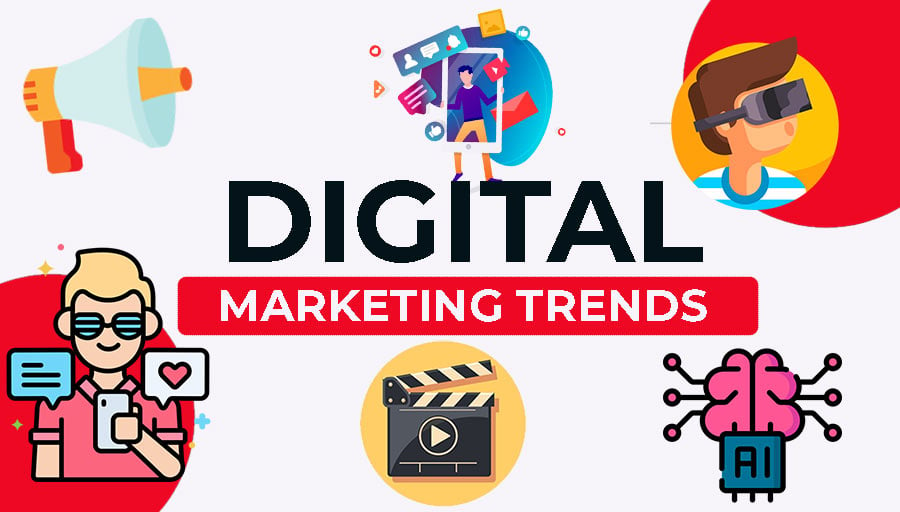Future Of Digital Marketing Trends unravels the dynamic realm of digital marketing, showcasing the latest developments that shape the industry and impact businesses worldwide.
From Artificial Intelligence and Video Marketing Evolution to Influencer Marketing Trends and Voice Search Optimization, this exploration delves into key aspects driving the future of digital marketing.
Digital marketing trends refer to the ever-evolving strategies, techniques, and technologies used in the digital marketing landscape. These trends are constantly changing in response to shifts in consumer behavior, advancements in technology, and updates in search engine algorithms.
Staying updated on digital marketing trends is crucial for businesses to remain competitive and relevant in today’s fast-paced digital world. By keeping abreast of the latest trends, businesses can adapt their marketing strategies to reach their target audience more effectively, improve brand visibility, and drive better results.
- Video Marketing: The rise of video content across social media platforms has been a significant trend in recent years. Brands are leveraging video content to engage audiences, showcase products/services, and tell compelling stories.
- Voice Search Optimization: With the increasing popularity of voice assistants like Siri and Alexa, optimizing content for voice search has become essential. Businesses are focusing on creating conversational and long-tail -rich content to improve their visibility in voice search results.
- Augmented Reality (AR) and Virtual Reality (VR): AR and VR technologies have revolutionized the way businesses interact with their customers. Brands are using AR and VR to offer immersive experiences, enhance product visualization, and drive customer engagement.
- Personalization: Tailoring marketing messages and content to individual preferences and behaviors has become a key trend in digital marketing. By leveraging data analytics and AI, businesses can deliver personalized experiences that resonate with their target audience.
Artificial Intelligence (AI) is revolutionizing the landscape of digital marketing by enabling businesses to automate tasks, analyze data more effectively, and personalize customer experiences on a large scale. AI technologies are being integrated into various aspects of digital marketing strategies to optimize campaigns, improve targeting, and enhance overall customer engagement.

Personalized Marketing
AI applications play a crucial role in personalized marketing by leveraging data analytics and machine learning algorithms to create tailored content and targeted ads for individual customers. By analyzing user behavior, preferences, and purchase history, AI can predict consumer needs and deliver personalized recommendations in real-time. For example, e-commerce platforms use AI-powered recommendation engines to suggest products based on past purchases, browsing history, and demographic information. This personalized approach not only enhances customer satisfaction but also increases conversion rates and drives sales.
Improving Customer Experience
AI is also instrumental in improving customer experience across various touchpoints in the digital marketing funnel. Chatbots powered by AI algorithms can provide instant responses to customer queries, offer personalized recommendations, and guide users through the purchasing process. These virtual assistants are available 24/7, ensuring round-the-clock support and enhancing customer satisfaction. Additionally, AI-driven customer segmentation and targeting help businesses tailor their marketing messages to specific audience segments, resulting in more relevant and engaging interactions with customers.
Video Marketing Evolution
Video marketing has seen a significant evolution in the digital landscape, becoming a crucial component of digital marketing strategies. With the rise of social media platforms and the increasing consumption of video content by online users, businesses are leveraging videos to engage with their target audience effectively.
Short-Form vs. Long-Form Video Content Trends
Short-form videos, typically lasting no more than a few minutes, have gained popularity due to platforms like TikTok and Instagram Reels. These bite-sized videos are easily consumable and cater to the decreasing attention span of viewers. On the other hand, long-form videos, such as webinars, tutorials, and product demos, provide in-depth information and are ideal for educating the audience. Businesses often use a mix of short-form and long-form videos to appeal to different segments of their target market.
- Short-form videos are ideal for creating quick brand awareness and capturing the audience’s attention.
- Long-form videos allow for a deeper dive into a topic, showcasing expertise and building credibility.
- Both short-form and long-form videos have their place in a comprehensive video marketing strategy, catering to different stages of the buyer’s journey.
Effectiveness
Video marketing has proven to be highly effective in engaging audiences and driving conversions. According to a study by Wyzowl, 84% of consumers have been convinced to make a purchase after watching a brand’s video. Videos evoke emotions, tell compelling stories, and offer a more immersive experience compared to text-based content.
- Video content generates higher engagement rates on social media platforms, leading to increased visibility and brand recognition.
- Live videos, in particular, allow for real-time interaction with the audience, fostering a sense of authenticity and trust.
- Personalized video messages can help businesses establish a deeper connection with their customers, leading to improved retention and loyalty.
Influencer Marketing Trends
Influencer marketing has become a pivotal strategy for brands looking to connect with their target audience in a more authentic and engaging way. By leveraging the reach and influence of individuals on social media platforms, brands can tap into a highly engaged audience and drive brand awareness, credibility, and ultimately, conversions.
Micro vs. Macro Influencers
Influencers come in all shapes and sizes, from micro-influencers with a smaller but highly engaged following to macro-influencers with a larger reach. Both types of influencers have their own unique advantages and can impact brands in different ways.
- Micro-Influencers:
- Micro-influencers typically have a smaller following, but their audience is highly engaged and niche-specific.
- They often have a more personal connection with their followers, leading to higher levels of trust and authenticity.
- Brands can benefit from working with micro-influencers by reaching a more targeted audience and achieving higher levels of engagement.
- Macro-Influencers:
- Macro-influencers have a larger reach and can help brands reach a wider audience quickly.
- They are often well-known personalities with a significant social media presence, making them ideal for boosting brand visibility and awareness.
- While macro-influencers may have a broader reach, their engagement rates may not be as high as micro-influencers.
Successful Influencer Marketing Collaborations
Numerous brands have successfully leveraged influencer marketing to drive brand awareness, engagement, and sales. Some notable examples include:
1. Daniel Wellington x Influencers: The watch brand collaborated with numerous fashion and lifestyle influencers to showcase their products, leading to a significant increase in brand visibility and sales.
2. Gymshark x Fitness Influencers: Gymshark partnered with fitness influencers to promote their activewear, resulting in a boost in brand credibility and a surge in sales within the fitness community.
3. Glossier x Beauty Influencers: Glossier worked with beauty influencers to create buzz around their products, leading to a cult-like following and strong brand loyalty among consumers.
Voice Search Optimization
Voice search optimization is becoming increasingly important in digital marketing as more people are using voice assistants such as Siri, Alexa, and Google Assistant to perform searches. Optimizing for voice search involves tailoring your content to match the natural language patterns used in spoken queries, as opposed to traditional text-based searches.
Key Strategies for Voice Search Optimization
- Create conversational content: Optimize your content to answer common questions and provide direct, concise answers that align with how people speak.
- Focus on local : Many voice searches are location-based, so ensure your business information is accurate and up-to-date on platforms like Google My Business.
- Use long-tail s: Voice searches tend to be more conversational and longer, so incorporating long-tail s into your content can help you rank higher in voice search results.
- Improve site speed: Voice search users expect quick results, so optimizing your website’s loading speed can improve user experience and search rankings.
Impact of Voice Assistants on Search Behavior
Voice assistants have drastically changed the way people search for information online. With voice search, users can perform hands-free searches while multitasking, leading to more conversational and specific queries. This shift in search behavior necessitates a change in digital marketing strategies to accommodate the growing popularity of voice search. Businesses that optimize their content for voice search are more likely to appear in voice search results and reach a wider audience through this emerging technology.
Social Commerce Trends
Social commerce, the merging of e-commerce and social media platforms, has been steadily rising in popularity and significance in the digital marketing landscape. This trend allows consumers to browse, shop, and purchase products directly within their favorite social media platforms, making the shopping experience more seamless and convenient.
Rise of Social Commerce
The rise of social commerce has transformed the way businesses interact with their customers and sell their products. Social media platforms like Instagram, Facebook, and Pinterest have introduced features that enable users to shop directly from posts, stories, and ads. This integration of shopping capabilities within social media channels has blurred the lines between social interaction and online shopping, creating a more immersive and interactive shopping experience for consumers.
Implications for Digital Marketing
The implications of social commerce for digital marketing are significant. Businesses can leverage social media platforms to reach a larger audience, drive sales, and build brand loyalty. By creating engaging and shoppable content, companies can increase conversions and revenue while providing a more personalized shopping experience for their customers.
Successful Social Commerce Campaigns
Some examples of successful social commerce campaigns include the “Shop Now” buttons on Instagram, influencer collaborations promoting products on TikTok, and Facebook Marketplace for buying and selling goods within the platform. These campaigns have shown the power of social commerce in driving sales and engaging consumers in a more direct and interactive way.
Social Media Integration with E-commerce Features
Social media platforms are continuously integrating e-commerce features to enhance the shopping experience for users. For example, Instagram has introduced shopping tags in posts and stories, allowing users to purchase products without leaving the app. Facebook has also incorporated a marketplace where users can buy and sell items within the platform. These integrations streamline the purchasing process and encourage impulse buying, making social commerce a valuable tool for businesses looking to capitalize on the power of social media for selling products.
As we conclude our journey through the Future Of Digital Marketing Trends, it becomes evident that adaptability and innovation are paramount in harnessing the potential of emerging trends to stay ahead in the competitive landscape of digital marketing.












